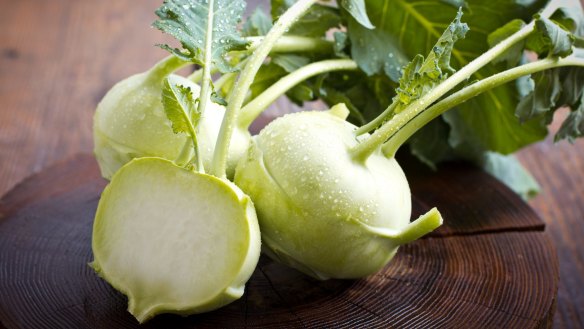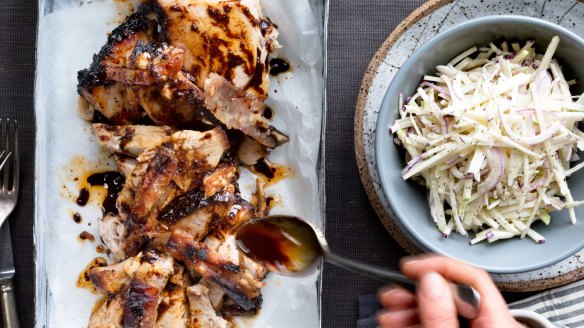Kohlrabi: Everything you need to know

What is it?
Kohlrabi is the swollen base of the stem of a form of cabbage. About the size of a grapefruit, it grows above the ground with scant upright leaves, which are edible, growing from the top of the bulb. The name comes from an erroneous belief that it is a cross between a cabbage and a radish. Kohl is German for cabbage, and turnip's species name is rapa. Kohlrabi is a winter crop, and has been used since the 1300s in France and Germany. Until the 20th century, it was used as cattle fodder in Britain, which would explain its late arrival in the Australian food chain. There is red and green-skinned kohlrabi, but both have creamy pale flesh.
Why do we love it?
Winter and early spring is the peak time of the year for brassicas – the cabbage family. When the cold weather hits, and the damaging frosts fall, brassicas protect their leaves by converting starch into sugar. Sugar acts as an antifreeze, lowering the freezing point at which ice crystals break apart cell walls. So cold-weather kohlrabi has a lovely sweetness. They also have an apple-like crispness and a faint aroma of savoy cabbage and radish, and so for those not keen on cabbage and the like, kohlrabi is considered the gateway vegetable to the world of brassicas. Inexpensive, packed with fibre and, like all brassicas, full of antioxidants – so they are good for you.

Who uses it?
David Moyle, the creative director of Harvest Newrybar near Byron Bay, says, "I think of kohlrabi basically in the same way as an apple." He says kohlrabi is a lot about the crunch. He likes to slice it wafer-thin using a mandolin or exceptionally sharp knife and pickles the slices in a sweet brine with a little vinegar for four to five hours. "I'll wrap these around a mussel or some other seafood for a little snack with a sweet, salty kick, and a little crunch next to the richness of the seafood," he adds. Moyle says that, like potato, kohlrabi becomes a little bitter when browned or grilled. "So cook it in a little stock, perhaps a seaweed stock, and finish with butter. Perfect with chicken."
Rosalin Virnik from Anchor Restaurant in Melbourne's Elwood says: "Make a remoulade by making a fine julienne of kohlrabi and celeriac. Through this, mix whole egg mayonnaise freshly made with extra virgin olive oil combined with grapeseed oil and emulsified with freshly squeezed lemon and Dijon mustard. Finish with fresh tarragon and a little dill." At Anchor Restaurant, she serves this remoulade with chopped king prawns served with lettuce inside a house-made brioche bun for their prawn cocktail roll served during lockdown from their takeaway at 133 Ormond Road, Elwood.
How do you use it?
If you don't have one, get yourself a Japanese Benriner mandolin. It turns veg into julienne in seconds. Mix julienned apple, kohlrabi and celeriac mixed with mayo blitzed with walnuts to make a quick Waldorf-inspired salad to serve with steak. You might want to try a slaw made with kohlrabi, apple and green chilli or try buttery creamed kohlrabi or braised kohlrabi with chicken.
Where do you get it?
Greengrocers, markets, farmers' markets and supermarkets. Buy small, plump, smooth kohlrabi. Remove the leaves (good for stir-fry) and store them in the fridge.
